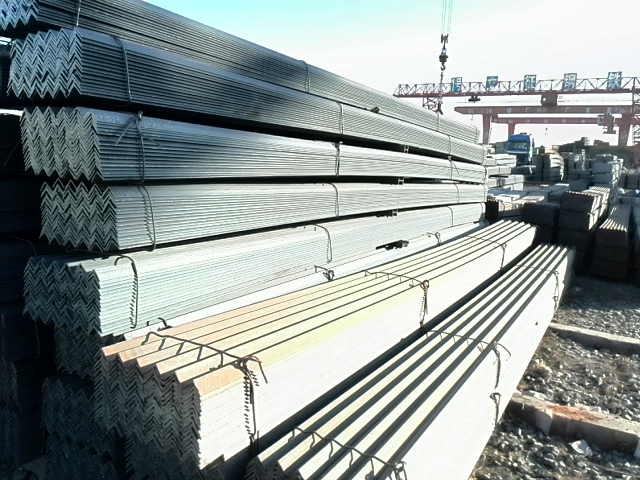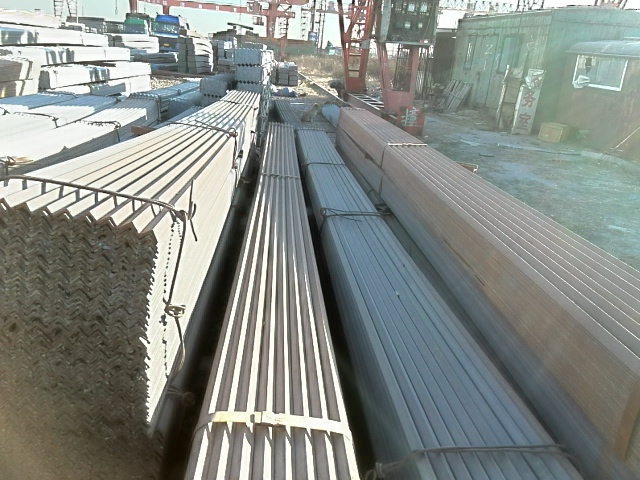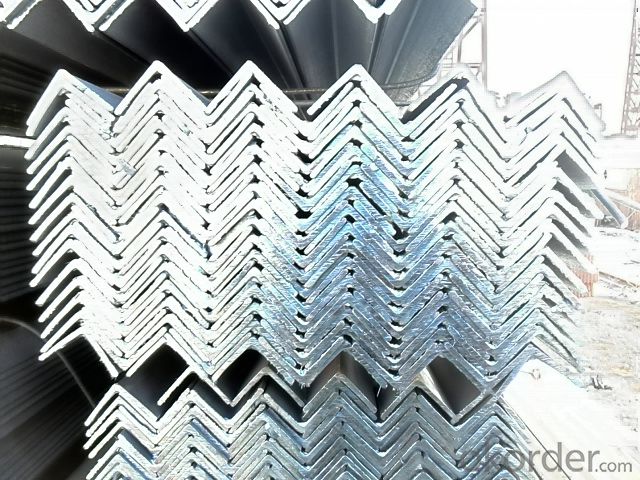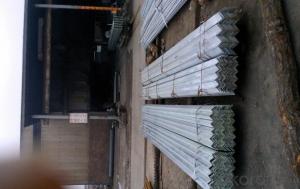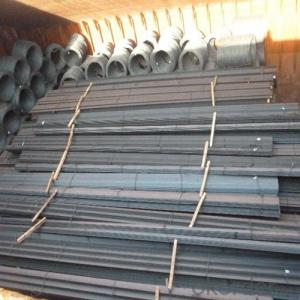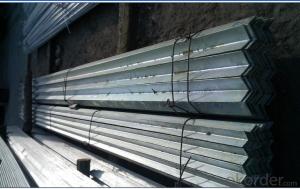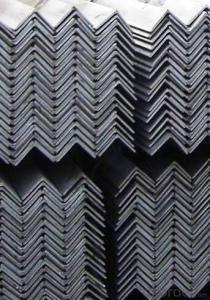Angle Steel Bars for Warehouse Buildings
- Loading Port:
- Tianjin
- Payment Terms:
- TT or LC
- Min Order Qty:
- 25 m.t.
- Supply Capability:
- 10000 m.t./month
OKorder Service Pledge
OKorder Financial Service
You Might Also Like
Product Description:
OKorder is offering high quality Hot Rolled Equal Angle Steel at great prices with worldwide shipping. Our supplier is a world-class manufacturer of steel, with our products utilized the world over. OKorder annually supplies products to European, North American and Asian markets. We provide quotations within 24 hours of receiving an inquiry and guarantee competitive prices.
Product Applications:
Hot Rolled Equal Angle Steels are ideal for structural applications and are widely used in the construction of buildings and bridges, and the manufacturing, petrochemical, and transportation industries.
Product Advantages:
OKorder's Hot Rolled Equal Angle Steels are durable, strong, and resist corrosion.
Main Product Features:
· Premium quality
· Prompt delivery & seaworthy packing (30 days after receiving deposit)
· Corrosion resistance
· Can be recycled and reused
· Mill test certification
· Professional Service
· Competitive pricing
Product Specifications:
Manufacture: Hot rolled
Grade: Q195 – 235
Certificates: ISO, SGS, BV, CIQ
Length: 6m – 12m, as per customer request
Packaging: Export packing, nude packing, bundled
EQUAL ANGLES SIZES |
| ||
a(mm) | a1(mm) | thickness(mm) | length |
25 | 25 | 2.5---3.0 | 6M/12M |
30 | 30 | 2.5---4.0 | 6M/12M |
38 | 38 | 2.5 | 6M/12M |
38 | 38 | 3.0---5.0 | 6M/12M |
40 | 40 | 3.0---6.0 | 6M/12M |
50 | 50 | 3 | 6M/12M |
50 | 50 | 3.7---6.0 | 6M/9M/12M |
60 | 60 | 5.0---6.0 | 6M/9M/12M |
63 | 63 | 6.0---8.0 | 6M/9M/12M |
65 | 65 | 5.0---8.0 | 6M/9M/12M |
70 | 70 | 6.0---7.0 | 6M/9M/12M |
75 | 75 | 5.0---10.0 | 6M/9M/12M |
80 | 80 | 6.0---10.0 | 6M/9M/12M |
90 | 90 | 6.0---10.0 | 6M/9M/12M |
100 | 100 | 6.0---12.0 | 6M/9M/12M |
120 | 120 | 8.0-12.0 | 6M/9M/12M |
125 | 125 | 8.0---12.0 | 6M/9M/12M |
130 | 130 | 9.0-12.0 | 6M/9M/12M |
140 | 140 | 10.0-16.0 | 6M/9M/12M |
150 | 150 | 10---15 | 6M/9M/12M |
160 | 160 | 10---16 | 6M/9M/12M |
180 | 180 | 12---18 | 6M/9M/12M |
200 | 200 | 14---20 | 6M/9M/12M |
FAQ:
Q1: Why buy Materials & Equipment from OKorder.com?
A1: All products offered byOKorder.com are carefully selected from China's most reliable manufacturing enterprises. Through its ISO certifications, OKorder.com adheres to the highest standards and a commitment to supply chain safety and customer satisfaction.
Q3: How soon can we receive the product after purchase?
A3: Within three days of placing an order, we will begin production. The specific shipping date is dependent upon international and government factors, but is typically 7 to 10 workdays.
Q3: Can stainless steel rust?
A3: Stainless does not "rust" as you think of regular steel rusting with a red oxide on the surface that flakes off. If you see red rust it is probably due to some iron particles that have contaminated the surface of the stainless steel and it is these iron particles that are rusting. Look at the source of the rusting and see if you can remove it from the surface.
Images:
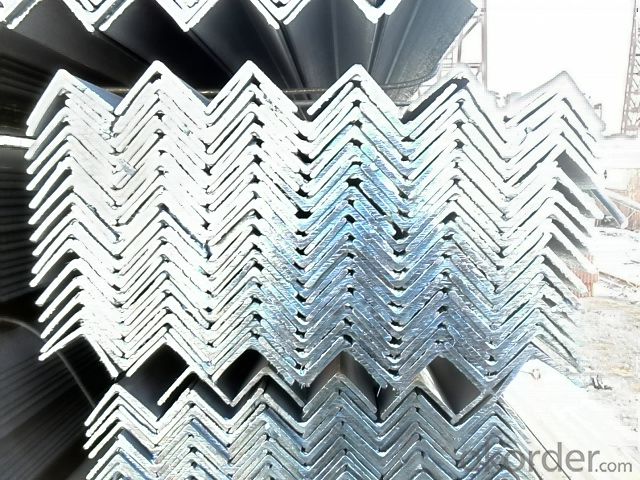
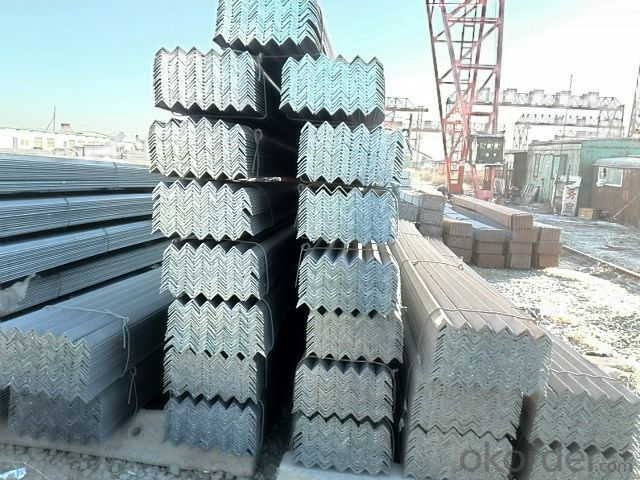
- Q: What are the different methods for cleaning steel angles?
- There are several methods for cleaning steel angles, including using solvents or degreasers to remove dirt and grease, scrubbing with a wire brush or abrasive pad to remove rust or corrosion, and using specialized cleaning agents or acid solutions for more stubborn stains or buildup. Additionally, power washing or sandblasting can be used to effectively clean larger steel angles.
- Q: What are the different surface finishes for steel angles?
- There are several different surface finishes available for steel angles, depending on the desired aesthetic and functional requirements. Some of the most common surface finishes for steel angles include: 1. Mill Finish: This is the most basic and untreated finish, which is obtained directly from the mill without any additional treatment. It has a rough and dull appearance, with visible mill scale and imperfections. 2. Hot-dip Galvanized: In this process, the steel angle is immersed in a bath of molten zinc, which forms a protective coating on the surface. This finish provides excellent corrosion resistance, making it suitable for outdoor and marine applications. 3. Powder Coated: Powder coating involves applying a dry powder to the steel angle and then curing it through heat, forming a durable and smooth finish. It offers a wide range of color options and provides good corrosion resistance and aesthetics. 4. Painted: Steel angles can be painted using various types of paint, such as enamel, epoxy, or acrylic. This finish not only enhances the appearance but also provides some level of protection against corrosion. 5. Stainless Steel: Steel angles can be made from stainless steel, which has a natural, corrosion-resistant surface finish. Stainless steel angles are commonly available in a brushed or polished finish, which provides a clean and shiny appearance. 6. Galvannealed: This is a specialized surface finish that involves galvanizing the steel angle and then heat treating it to form a matte, grayish finish. It offers good corrosion resistance and paint adhesion, making it suitable for applications requiring both. These are just a few of the different surface finishes available for steel angles. The choice of finish will depend on factors such as the intended use, environment, and desired appearance of the steel angle.
- Q: What is the typical yield stress of steel angles?
- The typical yield stress of steel angles can vary depending on the specific grade and type of steel being used. However, for commonly used carbon steels, the typical yield stress ranges from 36,000 to 50,000 pounds per square inch (psi). This means that the steel angles can withstand a certain amount of stress or pressure before they begin to deform or permanently change shape. It is important to note that different steel alloys and treatments can result in varying yield stresses, so it is necessary to consult the specific specifications or reference materials for the particular steel angle in question.
- Q: Can steel angles be used in railway track construction?
- Yes, steel angles can be used in railway track construction. Steel angles are often used as a structural component in the construction of railway tracks. They provide strength and stability to the track system, helping to support the weight of the train and distribute the load evenly. Steel angles are commonly used for the construction of rail joints, which connect two sections of rail together, as well as for the installation of rail fastenings and track accessories. They are durable, resistant to wear, and can withstand heavy loads and high impact forces, making them an ideal choice for railway track construction.
- Q: What are the different design considerations for steel angles in architectural applications?
- Some of the different design considerations for steel angles in architectural applications include the load-bearing capacity, structural stability, aesthetic appeal, corrosion resistance, and ease of installation. Additionally, factors like the size and shape of the angles, the type of steel used, and the specific architectural requirements also play a role in the design process.
- Q: What is the maximum length of a steel angle available in the market?
- The market offers steel angles in varying lengths based on the supplier and the specific type of steel angle. Generally, lengths for steel angles range from 20 feet (6.1 meters) to 40 feet (12.2 meters). It is worth mentioning that these lengths are commonly found for standard steel angles, but there may be customized options that surpass these lengths for specific projects or applications. It is recommended to consult the supplier or manufacturer to ascertain the maximum length available for a particular steel angle.
- Q: Are steel angles fire-resistant?
- Yes, steel angles are fire-resistant to a certain extent. Steel is a non-combustible material, meaning it does not burn or contribute fuel to a fire. It has a high melting point, usually around 1370°C (2500°F), which allows it to maintain its structural integrity even under high temperatures. However, it is important to note that while steel itself is fire-resistant, the fire resistance of a structure or component depends on various factors such as the design, size, and configuration of the steel angles, as well as the fire protection measures implemented. Fire protection methods like fire-resistant coatings, fireproofing materials, or fire-resistant insulation can be applied to steel angles to enhance their fire resistance. These additional fire protection measures can provide a certain level of insulation, delaying the transfer of heat to the steel and extending the time it takes for the steel to reach its critical temperature. This allows occupants more time to evacuate the building and firefighters more time to control the fire. In summary, steel angles are inherently fire-resistant due to the properties of steel, but their fire resistance can be further enhanced by implementing appropriate fire protection measures.
- Q: Can steel angles be used in modular building systems?
- Yes, steel angles can be used in modular building systems. Steel angles are commonly used in construction due to their strength and versatility. They provide structural support and stability to the building system. In modular construction, steel angles can be used as framing members, connectors, or reinforcements, depending on the specific requirements of the building design. They can be easily attached and integrated into the modular system, allowing for efficient and cost-effective construction. Additionally, steel angles offer durability and resistance to various environmental factors, making them suitable for modular buildings that need to withstand different conditions. Overall, steel angles are a reliable and practical choice for modular building systems.
- Q: Can steel angles be used for equipment racks or shelving?
- Equipment racks or shelving can indeed utilize steel angles. The robustness, endurance, and adaptability of steel angles make them widely employed in construction and fabrication. These angles offer structural reinforcement and steadiness, rendering them perfect for crafting resilient equipment racks or shelving units. By welding or bolting steel angles together, a sturdy framework can be created to hold an assortment of items, including weighty machinery, tools, or storage containers. Moreover, the flexible design of steel angles permits effortless customization and adjustment of shelf heights, making them suitable for accommodating diverse sizes and types of objects. In conclusion, steel angles are a dependable choice for constructing equipment racks or shelving systems that necessitate strength, stability, and longevity.
- Q: What do you mean by "corner steel plate pull knot"?
- The specifications are expressed in millimeters of edge width * edge width * edge thickness. Such as "30 x 30 x 3", that is 30 mm width equal angle, edge thickness of 3 mm. Also available models that model is the number of centimeters wide, such as 3#. The model does not mean the size of the different edges and sizes of the same model. Therefore, the width, the edge and the thickness of the angle iron should be filled out in the contract and other documents, so as not to be indicated by the model alone. Standard Specification for hot-rolled equal angle iron is 2#-20#.
Send your message to us
Angle Steel Bars for Warehouse Buildings
- Loading Port:
- Tianjin
- Payment Terms:
- TT or LC
- Min Order Qty:
- 25 m.t.
- Supply Capability:
- 10000 m.t./month
OKorder Service Pledge
OKorder Financial Service
Similar products
Hot products
Hot Searches
Related keywords



